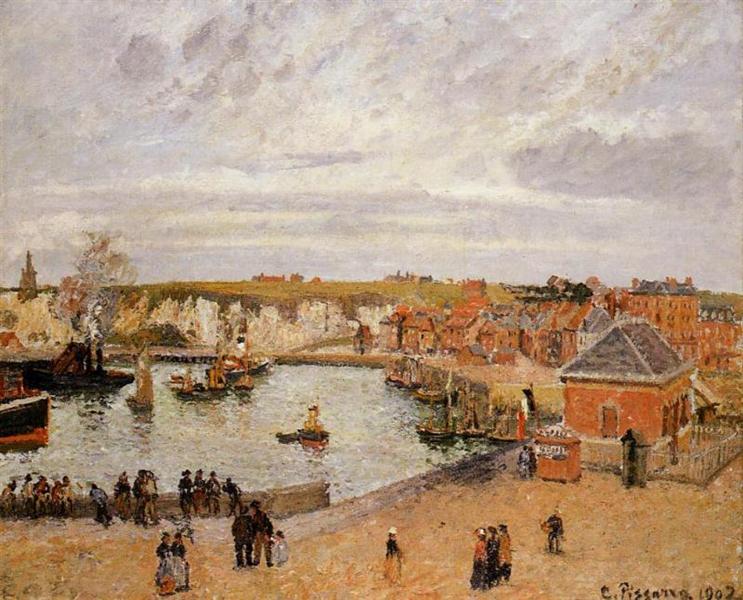Description
Camille Pissarro's painting "The Port of Dieppe", created in 1902, is a notable example of the artist's mastery within the Impressionist movement. In this work, Pissarro captures a vibrant and life-filled view of the port of Dieppe, a place he had a special connection with after spending time there on his travels throughout France. The composition, packed with a range of details, offers an intimate look at the bustling port environment, evidencing not only his technical skill, but also his ability to evoke the spirit of everyday life.
The use of colour is fundamental in this work. Pissarro employs a palette of bright and diverse tones that range from the blue reflections of the water to the warm earthy tones of the boats and buildings in the port. There is a dynamic play of light and shadow, where the sunlight seems to dance on the waves, creating an almost palpable effect of movement. The loose and energetic brushstrokes, characteristic of Impressionism, provide a sense of immediacy and freshness, underlining the ephemeral nature of the moment depicted. This technique, which allows the canvas to breathe and manifest itself in a vibrant effervescence, becomes a personal signature of Pissarro, which prevents him from falling into the rigidity of the academic.
In the scene, several boats and figures stand out, contributing to the visual narrative of the port. Although the human figures are small compared to the enormity of the surroundings, their presence is vital. These silhouettes seem to be immersed in various activities, reflecting the dynamism and continuous work that characterizes a fully functioning port. The boats, with their sails unfurled, become main actors that blend harmoniously with human activity, creating a symphony of movement and color that describes not only a place, but a community.
Pissarro, renowned for his focus on light and atmosphere, captures in this work the essence of the coastal landscape and the human character that inhabits it. From the angle chosen by the artist, the viewer feels invited to share this vision, to immerse themselves in the narrative of the port and to momentarily experience the reality of those times. The work reflects Pissarro's transition towards a freer and more experimental approach, an evolution that becomes evident when comparing his earlier works, such as "The Garden of Pissarro's House at Éragny" (1886), with the recent works in his career.
Historically, The Port of Dieppe is set in a context of exploration and change in artistic representation, highlighting the characteristics of Impressionism that were developing in the 19th century. Pissarro, one of the founders of the movement, stressed the importance of capturing light, colour and everyday life in his works, transforming the perception of art in his time. This painting, in particular, reinforces his vision and passion for the place, contributing to his legacy and the evolution of modern art.
The Port of Dieppe is thus a rich expression of Pissarro's vision, a testament both to the environment it depicts and to his own evolution as an artist. In looking at it, the viewer not only witnesses a vibrant port, but also becomes part of an ephemeral moment, suspended between light, water and life. Essentially, this painting continues the visual dialogue that Pissarro established between nature and humanity, resonating through the decades with its vivacity and authenticity.
KUADROS ©, a famous painting on your wall.
Hand-made oil painting reproductions, with the quality of professional artists and the distinctive seal of KUADROS ©.
Painting reproduction service with satisfaction guarantee. If you are not completely satisfied with the replica of your painting, we will refund 100% of your money.

